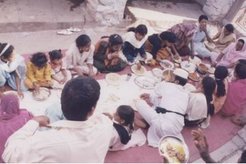An Afro-Indian Community in Karnataka, India: A Study of Ethnic Identity, its Maintenance and Change
An Afro-Indian Community in Karnataka, India: A Study of Ethnic Identity, its Maintenance and Change
Another reason to choose this area is that the Siddi of Karnataka are still unknown (and even unheard of) in the academic circle. This community is relatively unique in that, despite its presence in India for hundreds of years, its members have kept their distinctness from their neighbouring host societies in several respects and are the least assimilated Siddis of India. I hope this study will contribute its share, or at least arouse an interest in the academic circle for further inquiry and study of the cultural assets of the Siddi. I would like to study the nature of their ethnic identity, the extent of its maintenance and change, and the factors responsible for these. I shall examine both the physical and cultural boundary maintaining mechanisms. Besides, questions of the following sort shall be posed and addressed: How clear-cut or blurred are these boundaries? Which African cultural elements are still kept and why? What kind of minority versus majority relationships cross-cut these boundaries? How amicable or inimical are their interethnic relationships? Where are the Siddi found in the Indian caste strata? Further, the current arguments and counter-arguments into the theory of ethnicity and diaspora identity shall be debated in this project description.

Africans of the Orient and of the Occident have had contrasting experiences in their engagements with their contrasting host societies. As we can learn from historical documents, a considerable proportion of the Siddi, in spite of their original slave status, were raised to high-ranking positions, even at times, to the highest position of authority in some of the Muslim kingdoms of India. How did the Siddi, utilising their ethnic resources, achieve a better position among their hosts whereas the same could not be said of Africans in the western world?
To further clarify this point the following excerpts from two known scholars of history, namely, Rahman and Pankhurst will suffice. “The Shidi (Habshi or Siddi) was received in the Sindi (Indian) society as a unique creature. This ebony skinned, thick-lipped man with a head of extremely curly hair was strange to the Sindis. The feudal lord acquired this creature to amuse himself and adorn his court with” (Rahman 1976: 4). But “like the Turks who founded dynasties throughout the Mohammedan world, these Habshis usually began as slaves, and seem to have shown the same wonderful capacity, as did the Turks, for rising from slavery to the highest position” (Pankhurst 1972: 53).
Although slavery has been outlawed and abolished by almost all known governments since hundreds of years ago, its psychological impact and infamous social legacies upon posterities of slave populations are still visible. As a result, there is still a keen interest among several researchers in re-studying and re-analysing the topic of slavery. This is specially so among anthropologists and historians of the western world whose scholarly concern are the black communities of the Americas and of Europe. This has resulted in extensive research of the Atlantic Slave Trade and of western slavery. On the other hand, the topic still suffers from a huge void as the eastern counterpart of the Atlantic Slave Trade is yet under-represented in the academic research. This information gap has swayed the whole argument and its conclusion in a wrong direction. My research does its best to narrow this void.
In the case of the Atlantic Slave Trade, the racial dictum of the Bible was used to justify the slavery of the African people. In the case of the slave traffic across the Indian Ocean, it seems the Koran was sometimes used to serve the same purpose. The comparative study of the slave trades of the Atlantic and the Indian Ocean has a lot to tell about the two global religions involved in the trade-in-humans, namely, Christianity in the case of the Atlantic Slave Trade and Islam in the case of the Indian Ocean slave trade. This material can be a valuable asset for researchers who labor in anthropology of religion if they would like to conduct a comparative study of servile institutions either between a Hindu society and an Indian Muslim society, or between Islamic kingdoms of the East and Christian states of the West.
